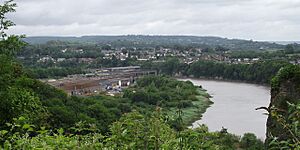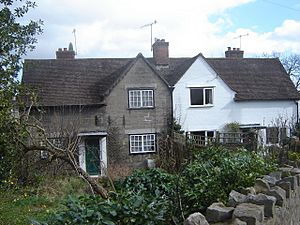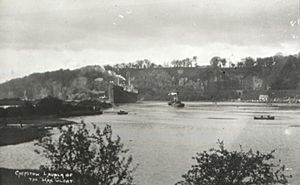National Shipyard facts for kids
The National Shipyards were a big plan in the United Kingdom during First World War. The government, led by David Lloyd George, wanted to build many more merchant ships. These ships were vital for carrying supplies.
Three main shipyards were planned. They were National Shipyard No.1 at Chepstow, No.2 at Beachley, and No.3 at Portbury. All these places were close to each other, near the River Wye and the Severn estuary. This plan started in 1917 because many Allied merchant ships were being sunk. German U-boat attacks caused these losses. Sadly, only one ship was finished before the war ended. Many people thought the project was a waste of money.
Contents
Why Were National Shipyards Needed?
During the First World War, Britain faced a "war on trade." German U-boats sank many British merchant ships in the Atlantic Ocean. In late 1916, about 180 ships were lost each month. Britain could only build a third of that number to replace them.
The government needed to build more cargo ships quickly. This would help keep supply routes open. In May 1917, Sir Eric Geddes became the head of the navy. Later that year, the government decided to build several National Shipyards. The goal was to build many "standard" cargo ships very fast.
They planned 41 slipways across the three sites. Chepstow would have 8 berths, Beachley 18, and Portbury 8. An extra 7 berths would be added at Chepstow by taking over Finch's Yard.
Building Prefabricated Ships
The shipyards were meant to build "N" design ships. These ships would be prefabricated. This means parts would be made in different factories across the country. Then, these parts would be sent by train to the shipyards for assembly.
The first ships were supposed to be launched in October 1918. Royal Engineers (army engineers) and German prisoners of war built the shipyards. Civilian workers would then assemble the ships. In March 1918, Geddes said Britain needed to almost double its shipbuilding output. This was necessary to make up for the ships being sunk.
National Shipyard No.1 at Chepstow
One of the main National Shipyards was in Chepstow, Monmouthshire. It grew from an existing shipyard next to the River Wye. This shipyard was started in 1916 by the Standard Shipbuilding Company. They aimed to mass-produce ships. They began building eight slipways for ships up to 600 feet long.
To make room for the shipyard, part of Chepstow's old 13th-century town wall was taken down. This also made space for railway tracks.
Housing for Workers
Over 6,000 skilled workers moved to Chepstow. They came from other shipbuilding areas like Tyneside and Clydeside. New homes were built for them in three "garden suburbs":
- 200 houses at Hardwick, Chepstow (now called "Garden City").
- 223 houses at Bulwark.
- 342 houses at Pennsylvania, Sedbury, for those working at Beachley.
Prisoners of war and the Royal Engineers helped build the shipyards and the concrete blocks for the houses. Temporary huts also provided housing. A new hospital was built in Chepstow.
However, the government took over the Standard Shipbuilding Company in August 1917. They put their own managers in charge. This actually slowed things down. The original owners did not want the government to take over. They said they had found the site and arranged housing. But the government felt the company was too slow.
Shipbuilding Progress at Chepstow
Parts for the first ship arrived at Chepstow in April 1918. But progress was slow. The way the project was run was criticized. Other shipyards and trade unions were unhappy. They did not like that military workers were used instead of civilians.
In August 1918, the Chepstow shipyard took over Finch's Works next door. The next month, the War Forest was launched. This was a C-Class Standard Ship. It was the first standard ship launched from any National Shipyard. It was used until 1943 when it was sunk. However, by the end of the war in November 1918, no prefabricated ships had been fully built.
National Shipyard No.2 at Beachley
At Beachley in Gloucestershire, construction of National Shipyard No.2 began in 1917. This site was downstream from Chepstow, on the other side of the Wye. Prisoners of war were used for the work. They lived in camps at Beachley and Sedbury. All the villagers at Beachley had been told to leave with only 11 days' notice.
A railway line was built from Tutshill. A new power station, slipways, assembly buildings, and houses were also constructed. This cost over £2 million. But the work was not finished when the war ended. The only ship started there, the War Odyssey, was never completed.
National Shipyard No.3 at Portbury
The Portbury shipyard was located between Portishead and the mouth of the River Avon. This site later became the Royal Portbury Dock. This shipyard was also still being built when the First World War ended.
Why Were the Shipyards Criticized?
By July 1918, people in the House of Commons openly criticized the National Shipyards plan. Gerald France, a Liberal Member of Parliament, said it was "not a war emergency... but a speculative adventure." Sir Hamar Greenwood called the project a "scandal."
Greenwood said that the government's time and energy were being wasted. He felt they should focus only on the war. He said, "Up to the present not a ship has been produced, and there is no sign of a ship being produced for years." He urged the government to stop the project.
What Were the Costs?
The war ended in November 1918. In 1919, the total cost of the work at Chepstow and Beachley was announced. It was £6,120,000. This included:
- £162,000 to buy Finch's yard.
- £964,000 for Shipyard No.1.
- £1,933,000 for Shipyard No.2.
- £863,000 for houses and camps.
- £109,000 for the new Mount Pleasant Hospital.
What Happened to the Shipyards Later?
After the First World War, the Chepstow shipyard was briefly taken over by the Monmouthshire Shipbuilding Company. The busiest year was 1920. Eight ships were launched that year, totaling 40,510 tons. The largest ship was the War Glory, launched on April 21, 1920. It weighed 6,543 tons. It later became the Monte Pasubio and was wrecked off Argentina in 1924.
In 1924, the Fairfield Shipbuilding and Engineering Company bought the site. This company was based in Glasgow. The Chepstow works mainly built bridges and other large engineering structures. This continued during and after the Second World War. After Fairfield went out of business in 1966, the Mabey company took over the site.
In 2011, there were plans to redevelop the site for housing and offices. The Mabey Bridge engineering works would move to a new location. More detailed plans came out in 2014. In 2019, plans to build houses were approved. This housing development is called the Brunel Quarter. In October 2022, the site of the former No.4 slipway was opened as a public park.
Beachley Site's New Purpose
The Beachley site stayed under government control. In 1924, part of it became the Boys Technical College. This later became the Army Apprentices College and is now Beachley Barracks. This is the base for the 1st Battalion, The Rifles. In November 2016, the Ministry of Defence announced that the site would close in 2027.
You can still see parts of the old National Shipyard from aerial photos. These include embankments, slipways, sheds, accommodation blocks, and old railway lines.




